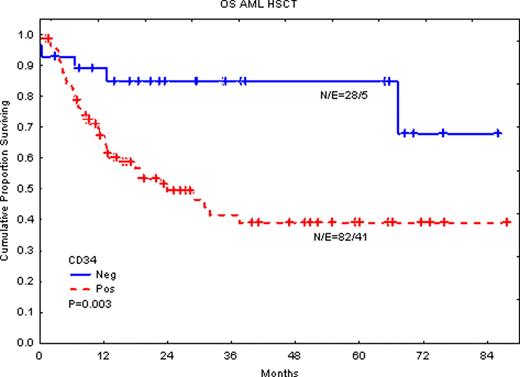Abstract
Abstract 1894
Most of the studies of prognostic factors in acute myeloid leukemia (AML) are focused on predicting outcome after standard chemotherapy treatment. The studies that looked at the importance of these prognostic variables in predicting outcome after hematopoietic stem cell transplantation (HSCT) are very limited. Considering post-HSCT prognostic factors in stratifying AML patients may add a new level of confidence in any risk stratification of these patients. Toward this goal, we investigated the clinical relevance of CD34 expression in the primary leukemic cells on the outcome of allogeneic HSCT.
Data collected from immunophenotyping of 110 patients with AML who were treated with HSCT was reviewed and the expression of CD34 on the blast population as determined by flow cytometry was correlated with clinical behavior and outcome. All the patients were treated with allogeneic HSCT. The median age of these patients was 24 (range: 14–57) and included 88 patients in the intermediate cytogenetic group and 22 in the adverse cytogenetic group. Of the 110 patients 71, (64.5%) were treated with HSCT in first remission (CR1).
Twenty-eight (25%) of all AML patients studied did not express CD34 on the surface of the blasts at diagnosis. Patients with CD34 negative blasts had significantly longer overall survival (OS) (P=0.003) as well as longer event free survival (EFS) (P=0.01) when all patients were considered. In the subgroup of patients who received HSCT in CR1, OS and EFS were significantly longer (P=0.017 and P=0.027, respectively) in the CD34-negative patients (N=20). Furthermore, if we consider only patients in the intermediate cytogenetic group at diagnosis, patients with CD34-negative blasts had significantly longer OS (P=0.007) and EFS (P=0.026). Even in patients with adverse cytogenetic abnormalities, OS and EFS were also significantly longer in the CD34-negative patients (P=0.01 for both). This was true when all patients were considered. The same was true when only patients transplanted in CR1 (P=0.05 for EFS in intermediate cytogenetics and P=0.05 for EFS in patients with adverse cytogenetic) were evaluated. Multivariate analysis including CD34 expression and FLT3 mutation status was carried out on a subset of patients (N=63) and showed CD34 expression was an independent prognostic factor for survival and EFS, while FLT3 mutation status became no longer a predictor.
Our data suggests that CD34 expression on the blast cells at the time of AML diagnosis may have an adverse prognostic impact even after allogeneic HSCT. Lack of CD34 expression is a powerful independent favorable prognostic factor for AML patients if these patients are treated with HSCT after induction chemotherapy, irrespective if they were in CR1 or in CR2, and irrespective of their cytogenetic risk at diagnosis.
No relevant conflicts of interest to declare.
Author notes
Asterisk with author names denotes non-ASH members.


This feature is available to Subscribers Only
Sign In or Create an Account Close Modal